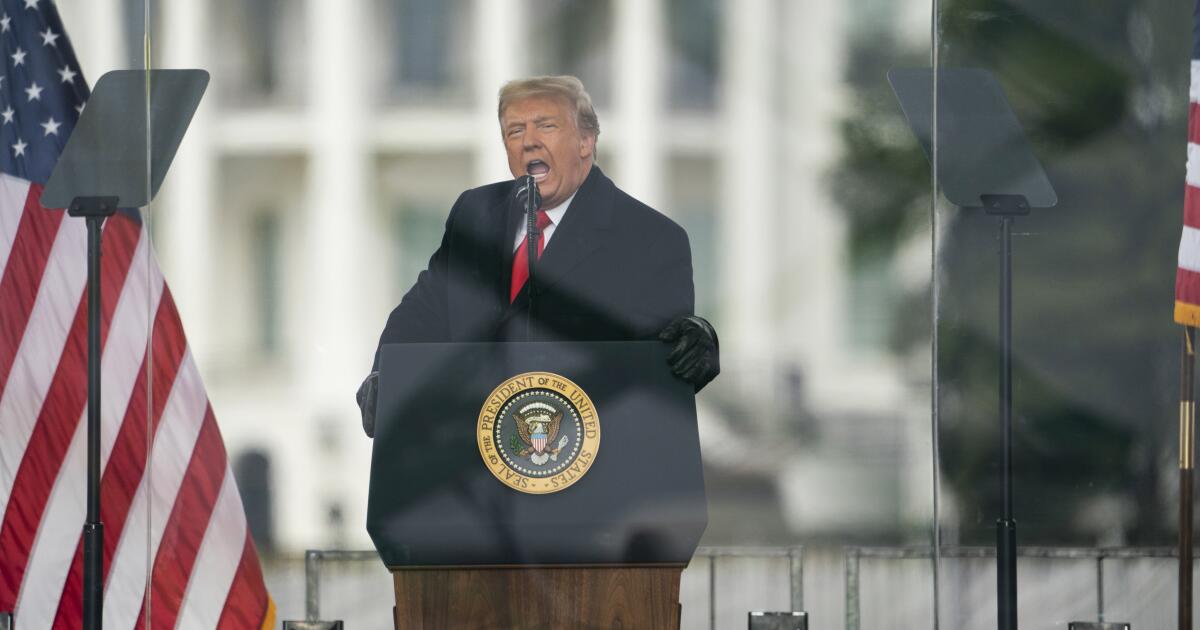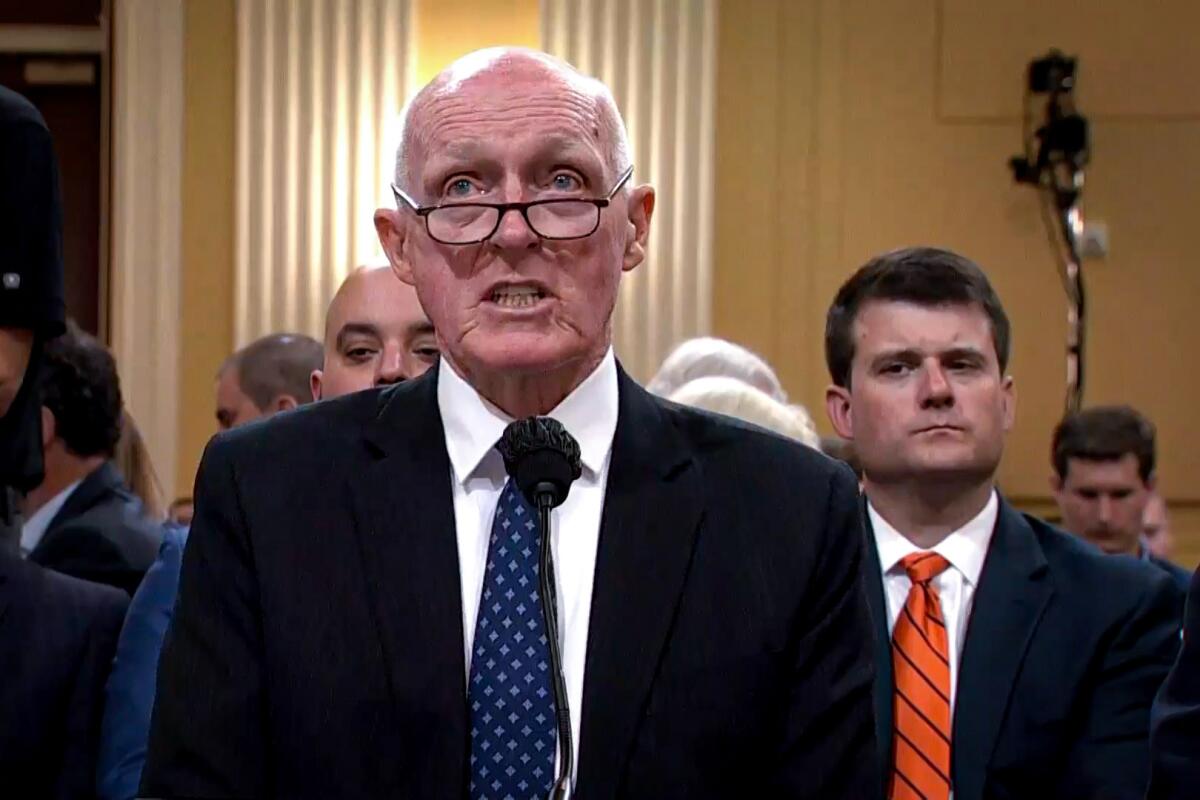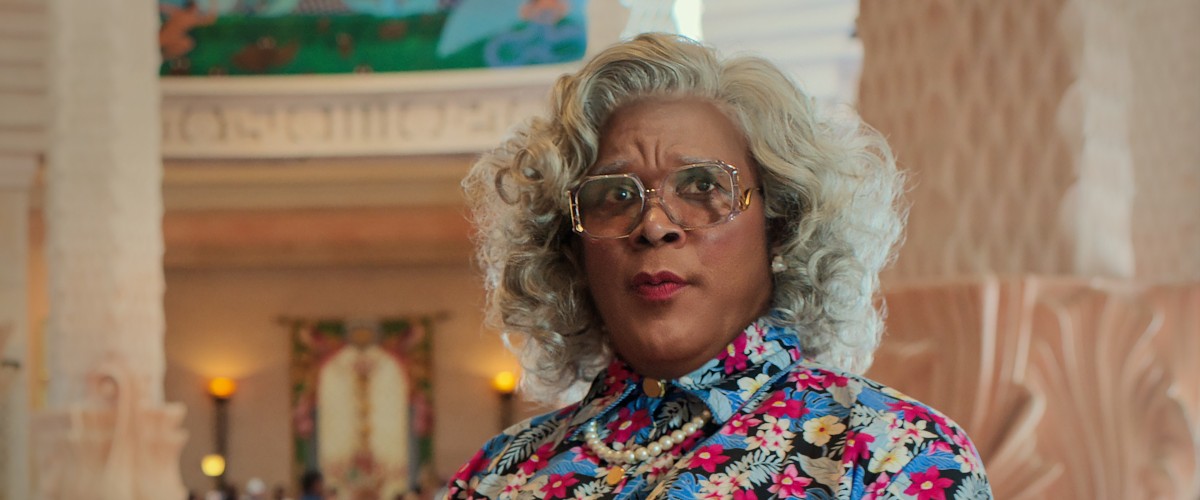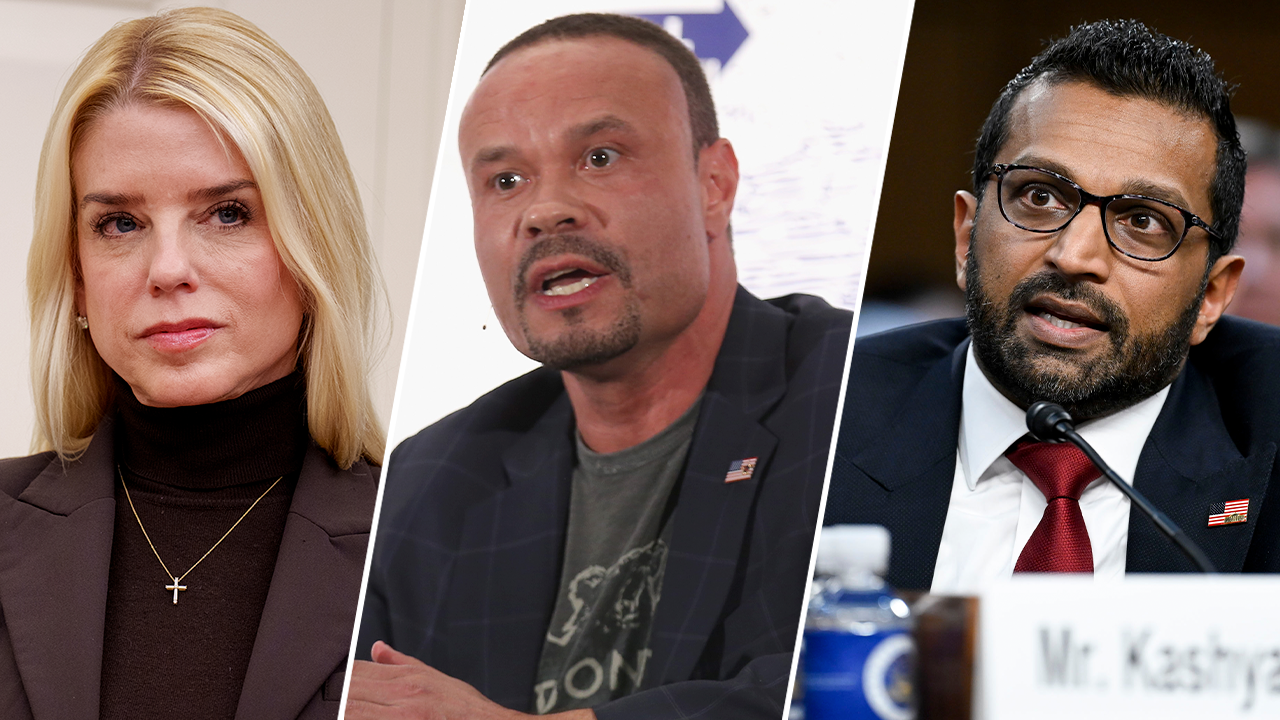Entertainment
'Stopping the Steal' examines Trump's attempt to subvert 2020 election, and what it means for 2024

Getting folks to watch a documentary about the Big Lie is a Big Ask. Who wants to relive that horrible chapter in America’s political history, especially while we’re writing a new, possibly less-horrible chapter?
Despite its title, HBO’s “Stopping the Steal” is as much about what lies ahead of us as it is about that other election that put Joe Biden in office and then-President Trump on a warpath. The 90-minute film, which premieres at 9 p.m. Tuesday on HBO, explores the depth and veracity of Trump’s scheme to overturn the election results through the first-hand accounts of the people who were there.
The collective stories of former Trump appointees, staffers and Republican elected officials, who worked and served behind the scenes in the months before and after the election, paint a picture of Trump’s brazen scheme to try to steal the election and what it took to stop him and his allies from succeeding.
Directed by Dan Reed (“The Truth vs. Alex Jones”), “Stopping the Steal” takes viewers back to July 2020, when the president’s popularity was slipping and the election was looming. “By late summer, President Trump starts to grease the wheels for excuses if he lost,” says Alyssa Farah Griffin, who served in 2020 as White House director of strategic communications and assistant to the president. And the film cuts to a summer presser where the former president proclaims, “These elections will be fraudulent. They’ll be fixed or rigged.”
Alyssa Farah Griffin, the White House director of strategic communications in 2020, in a scene from HBO’s “Stopping the Steal.”
(HBO)
Spanning to the Jan. 6, 2021, insurrection, the film explores chronologically how Trump attempted to hang onto the presidential office, no matter the cost. News and events we’re already familiar with — Trump’s vaguely threatening call to Georgia Secretary of State Brad Raffensperger demanding he “find” the president the votes he needed and Trump’s private admissions that he knew he lost to Biden — take on a new light through the accounts of those who stood between Trump and his nefarious plans.
“Up until the election, you could always appeal to his self-interest — ‘Mr. President, this is a bad idea for you. This will hurt you,’” says former Atty. Gen. William Barr, who served under Trump. “That would work if you appealed to his self-interest. That is what helped keep things within the guardrails.”
Barr says Trump embarked on a “destructive” campaign that reached new levels of depravity immediately following projections that Biden had won the election. “At 2 in the morning [Trump held a news conference], and for him to go out and claim that fraud was underway, it was very dangerous. I started worrying a lot from then on,” Barr says.

Also featured in the documentary is former U.S. Atty. Gen. William Barr.
(HBO)
Former Trump campaign and White House official Stephanie Grisham says when the president doubled down on the falsehood that the election was rigged, his staff likely knew better. They played along, though, because no one wanted to be the target of his anger. “I guarantee anyone that was around him at the time, despite what they were thinking inside, they were saying, ‘Oh it was stolen, sir,’” Grisham says.
The film juxtaposes accounts such as Grisham’s with footage of Trump and his Big Lie team (who included Rudy Giuliani, Jenna Ellis and Sidney Powell) spewing accusations about ballot tampering by poll workers, voting by “illegal aliens” and deceased people, and claims that Dominion Voting Systems’ electronic ballot machines had been hacked.
None of it was true, of course, but that didn’t stop them from leaning on local officials in critical swing states such as Arizona and Georgia. “I was for Trump the whole time … and then it started. The steal,” says former Arizona House of Representatives Speaker Rusty Bowers.
Bowers faced intense pressure from the president and Giuliani to go along with their illegal scheme to replace the state’s slate of electors with ones who would elect Trump. The Arizonan recalls an in-person meeting with Giuliani, where Bowers asked for evidence of election fraud. “Rudy, you have the proof?’ Yeah, yeah!’ [Then Jenna said] ‘Oh, I left it back at the hotel.’”
Like many others who refused to prop up the false allegations, Bowers was doxxed and threatened by legions of Trump’s supporters. The film makes it clear that Bowers is among the Republican officials who stood by their principles, but often at great personal cost.

Former Arizona Assembly Speaker Rusty Bowers testifying at a hearing about Jan. 6 and the post-election actions of former President Trump.
(FedNet)
Former Arizona Atty. Gen. Mark Brnovich was another avid Trump supporter heading into the 2020 election. “President Trump did a great job,” he says in the film. “I was right there with him. [Then] he called me and said, ‘Hey, you’ll be the most popular guy in America. You’ll be able to run for president. All you gotta do is say there’s fraud or find some fraud.’” Brnovich didn’t succumb to Trump’s demands, but he also didn’t investigate the matter of the fake electors scheme.
Other participants in the film, however, did put it all on the line to protect democracy, including Raffensperger; Maricopa County Board of Supervisors appointees Clint Hickman and Bill Gates; and Georgia Election Operations Manager Gabriel Sterling. Marc Short, then chief of staff for Vice President Mike Pence, also offers gripping insight into his former boss’ dangerous and precarious position.
Among those in the film who still insist the Big Lie is the Truth are Trump attorney and insurrection architect John Eastman. Also making an appearance is self-proclaimed “QAnon Shaman” Jacob Chansley. You may remember seeing footage of Chansley on Jan. 6, shirtless, clad in a furry, horned helmet and sporting red, white and blue face paint. There’s no need to quote him here.
We’ve lived through this story, so “Stopping the Steal” isn’t a cautionary tale. But it is a powerful reminder of what we should prepare for. “I think Jan. 6 is like the trailer to a movie,” Grisham says. “That’s the one thing with Donald Trump that I’ve learned. You think he’ll just go this far and there’s not more. There’s always more. He takes it as far as it will go.”

Movie Reviews
Movie Review: SUPERMAN

Hollywood never tires of telling certain stories. They’re always going back to the same well. Trust me, I’m a jerk, and I love to remind them of it. So, when DC announced Superman would once again be jump-starting their newly re-established cinematic universe, I was skeptical. Well, the comic book tentpole finally hit theaters this week. Does Superman leap to box office gold in a single bound? Or are we heading straight for another “Martha” situation? Read on.
Superman
Superman follows the titular superhero (David Corenswet), who finds himself struggling to match wits with supervillain, billionaire and all-around bad guy Lex Luthor (Nicholas Hoult). Will “Supes” be able to rise up and meet the challenge? Rachel Brosnahan, Skyler Gisondo, Nathan Fillion, Edi Gathegi and Isabela Merced co-star in the movie. James Gunn directs Superman from his own script.

I was admittedly skeptical looking at the trailers. I desperately wanted to buy in, but something kept holding me back. Do we really, truly need yet another Superman?
RELATED: 28 Years Later Spoiler Review
Kids, I could not have been more wrong. I should know this. Always trust in James Gunn. Few filmmakers feel quite as at ease with finding not only the heart but also the humor in a story. Gunn and Corenswet gel to find such a delightful sense of wonder in Superman, and this made the film for me.
Unassuming Sweetness
There’s a lot of pressure on Superman, and with that, a lot of focus on David Corenswet as he steps into the iconic titular role. Some should likely recognize him for his recent work in Twisters and Pearl. For most, though, this is the young actor’s big-screen breakout.


Corenswet brings an unassuming sweetness to the daunting part. As Superman, he’s a Boy Scout, and that’s okay. His sense of wide-eyed wonder is imperative to Gunn’s narrative vision and sells the story’s emotion. It’s easy to get caught up in Clark’s joy, and with that, his pain.
RELATED: M3GAN 2.0 Spoiler Review
David Corenswet is, however, only one member of a supremely talented cast. In truth, it would be impossible to call out all the stellar performances by both new and existing members of Gunn’s recurring acting troupe. With names like Nathan Fillion and Alan Tudyk in the cast, this felt like a return to a joyful old-school “Nerdvana,” the likes of which we haven’t seen in a long time.
A Crusading Reporter
However, there’s one more performance I’d be shirking my duties if I didn’t call out. Friends, I’ve been a Rachel Brosnahan fangirl going back to her days on Manhattan in 2014. It remains one of the best shows no one talked about, so call me biased. It’s probably true.


Perhaps it should come as no surprise that I’m in love with Brosnahan’s portrayal of Lois Lane. Her’s is a rare comic book love interest that steps beyond the usual formula. She has her own voice, her own life and a story that could easily be told. I’m officially sending a plea to the DC TV programming team. Can we get an Agent Carter-like series featuring Lois Lane as a crusading reporter? I would watch the heck out of that. We need that spin-off. We deserve that spin-off.
RELATED: Movie Review: The Old Guard 2
Doesn’t Break Its Stride
Gunn, meanwhile, is far from a newcomer to superhero films. We know this. I was pleasantly surprised to find, though, that Gunn avoids falling into the usual Superman traps. For one thing, this isn’t an origin story. We really didn’t need to see Smallville and what happens to Pa Kent yet again.
With that, I suppose, there are some light struggles with characterization. As the audience, we’re ushered into a fully established world. Gunn assumes (rightly so) that most already know Superman’s origin story. There’s some pointed narrative setup, but the film doesn’t break its stride to stop and fill in needless gaps.


Ultimately, though, Luthor’s “hands-off” villainy allows Superman to step into a different comic movie structure. The resulting film is packed to the gills with stunt set pieces. There’s plenty of comic action, but it never feels hurried or jammed, despite the fact that Lex Luthor throws a lot at our protagonist. With everything that happens, it’s hard to see where the next threat is coming from, and with that, there are stakes that often feel lacking in comic book movies. There’s a beautiful tension here.
RELATED: New TV Shows This Week (July 13-19)
A Wide-Eyed, Wonderful Look
As the final credits rolled, I found myself with the biggest smile on my face. Superman restarts the DC Cinematic Universe with infectious joy. This doesn’t feel like the same old Superman origin story, and that’s how it should be. This is a wide-eyed, wonderful look at the complicated truth of humanity. Here’s hoping the rest of Gunn’s DCU follows suit.
Superman is now playing in theaters nationwide.
Movie Review: JURASSIC WORLD REBIRTH
Entertainment
Blackpink pumps up the SoFi crowd with first U.S. show in two years

Blackpink is back in the area.
The K-pop girl group, made up of Rosé, Lisa, Jennie and Jisoo, triumphantly kicked off the North American leg of the Deadline world tour Saturday night at SoFi Stadium in Inglewood. After taking a two-year break to focus on solo projects, the group reunited for its first U.S. concert since the Born Pink tour concluded in 2023.
Despite dropping only one group number since then — hardstyle, Diplo-produced “Jump,” released Friday — Blackpink sold out two nights at one of the Los Angeles area’s biggest venues.
“This is incredible. It is such an honor to perform at the SoFi Stadium for you guys,” Rosé said. “We are really really excited to be here.”
Sarah Hoang has been a Blackpink fan since 2019, following their Coachella debut that same year. To celebrate her first time seeing the girl group, the San Diego resident passed out commemorative tickets to other fans.
“I’ve been waiting for them for a long time,” Hoang said. “I was really excited to be finally seeing them in L.A., especially at the first tour of the U.S. leg.”
The stadium was awash in pink as fans went all-out for their idols. While many dressed according to the band’s namesake, others took inspiration from the girls’ solo projects. Concertgoer Evelyn Rios, who lives in Los Angeles, nailed Jennie’s look from the “Ruby” album cover in her all-black outfit and cherry-red wig. A fan since 2020, she attended the 2023 show at Dodger Stadium and noted she was most excited to hear “like Jennie.”
The show consisted of five acts and an encore, alternating between group and solo sections. Blackpink started off strong, firing through “Kill This Love,” “Pink Venom” and “How You Like That.”
The Saturday night set list was identical to the one in Goyang, South Korea, last weekend, save for Lisa’s solo section. While the maknae — or youngest member of the group — performed “New Woman” and “Rockstar” for the tour’s opening dates, she opted for the edgier “Thunder” and “Fxck Up the World” Saturday night.
Lisa’s two-piece Louis Vuitton set evoked Wonder Woman as she conquered the stage, lightning crackling behind her. Channeling the same spellbinding energy from her Coachella set earlier this year, where she also performed tracks from “Alter Ego,” Lisa proved why she’s among K-pop’s most magnetic performers.
All four solo projects are sonically distinct, and seeing them back-to-back highlighted just how artistically diverse the Blackpink members are. Jennie, who also performed solo at Coachella this year, leaned into her hip-hop influences as she delivered a mashup of “Mantra,” “with the IE (way up)” and “like Jennie.” Meanwhile, Jisoo pleased with the effervescent, electronic pop of “earthquake” and “Your Love.”
Rosé prompted laughs from the audience as footage of her filming a TikTok and eating French fries backstage played leading up to her solo section. When she finally appeared in front of the audience, she took a more intimate approach, sitting at the edge of the stage with guitarist Johnny “Natural” Najera.
Starting with heartbreak anthems “3am” and “toxic till the end,” Rosé concluded with the upbeat, global chart-topping single “Apt.,” during which she brought a fan on stage. Released with Bruno Mars in October, the song still sits comfortably on the Billboard Hot 100.
Blackpink debuted “Jump” before its official release last weekend in South Korea, so Los Angeles fans were prepared for the long-awaited comeback single. They jumped and danced all the way through the addictive track when Blackpink performed it not once, but twice.
“I must say the song is really addictive the more and more I hear it,” Rosé said after the first run. “I personally think it’s the most exciting one to perform during our set.
With a mix of old and new hits, Saturday night brought together both longtime fans and K-pop newcomers.
Sydney Grube and Thet Aung drove up together from San Diego just for the concert. While Aung has been a fan since the group began, Grube started listening after seeing Lisa in HBO’s “White Lotus” in February.
“I started listening to all the solo acts, and then started listening actually to the Blackpink music,” Grube said, adding that she was most excited to see the individual sections.
The concert also united fans of all ages, with plenty of families arriving in coordinating outfits. At one point, Blackpink even shouted out all the “baby blinks” in the audience — many of whom were not even born when the group debuted in 2016.
“I did want them to dance more, but they did really good,” said 9-year-old Tara Castro, who was wearing a Blackpink hat and glasses. “They’re my favorite K-pop.”
With tour dates charted through January, fans are expecting new music — perhaps even a full album — sometime soon. Hopefully this isn’t the last we see of Blackpink in our area.
Movie Reviews
Madea’s Destination Wedding movie review (2025) | Roger Ebert

Tyler Perry wants to be taken seriously as a filmmaker, so this review of “Madea’s Destination Wedding” will do so. Even though it’s the latest in his series about his most famous character, the combative but goodhearted grandmama Mabel “Madea” Simmons, and is, like nearly all of the rest, fitfully amusing but slovenly and easily forgotten.
In this one, Madea and company head to the Bahamas and get into shenanigans at a luxury hotel. It’s unfortunately typical of Tyler Perry’s comedy output. It runs an hour and forty-five minutes but feels much longer. A strain of misogyny runs through it. It doesn’t introduce any story complications, much less any real stakes for the characters, until more than halfway through its running time. It largely consists of improv-heavy chunks of light clowning; that’s a strange phrasing, admittedly, but what else do you call a scene that doesn’t have anything resembling shape, much less a satisfying payoff?
Perry, as usual, is the credited writer and director in addition to playing multiple characters from Madea’s family, the Simmons, including Madea’s wild-haired, shambling, rascally brother Joe and their earnest son Brian, a prosecutor (played by Perry without special makeup). The story begins with a comedy set piece: Madea, her ex-husband Leroy Brown (David Mann), and their daughter Cora (Tamela Mann) getting accosted at a gas station by would-be robbers, whom Madea bashes into submission with her purse. Then we jump to Joe and his ex-wife Debra (Taja V. Simpson), a former drug addict who cleaned up and married a rich guy, in a fancy restaurant, where they are to be joined by their son B.J. (Jermaine Harris) and daughter Tiffany (Diamond White). Tiffany shows up with a dreadlocked young man named Zavier (Xavier Smalls) who exudes smugness and greets Joe with “Whassup, my n—a?” This is the prospective groom that Tiffany wants her dad to approve of. She’s never mentioned him until this moment.
The destination wedding of the title has already been locked into place by Debra’s rich husband, who is prepared to foot the bill for both the bride and groom’s families. Brian’s pride prevents him from accepting. He’s understandably peeved that Tiffany agreed to this scenario without introducing her man first, and thinks Zavier is a sleazy character. But Brian and other members of the family accept the arrangement and go to the Bahamas to support Tiffany, with Brian putting down a deposit for incidentals.
It takes half the movie for them to get to the Bahamas, check in, look at their rooms, and experience the many splendid areas of the hotel, which include a casino and a huge water slide. The scene where they check in takes several minutes. So does the scene where they figure out the logistics of their lavish suite of rooms. There’s a scene in a gift shop where lots of stuff is added to their bill, and scenes in the casino where Joe gambles and tells the house to add his tally to the bill. You can see where things are going.
There’s a funny, purposefully overwrought sequence where Xavier invites Joe and Leroy to his bachelor party. Joe convinces the pious and clean-living Leroy that it’s a gospel-themed party, practically a church service. Leroy ends up surrounded by scantily clad, twerking dancers, shrieks like a child, and sprinkles them with holy water. Perry is often a hoot playing both Madea and Joe (who twerks very slowly while balancing on his cane). But there’s a lot of flab in the scenes of banter and misunderstanding.
“The Nutty Professor” this ain’t. Little thought has been given to how people end up where they need to be to overhear something they shouldn’t or interfere in a conversation that was supposed to be private. Sometimes people walk up and stand there in plain view while the others remain oblivious to their presence. Farce should be more meticulous than this. It’s like Perry isn’t even trying. Quality control is low even by his hit-and-miss, too-many-movies-a-year standards.
You could say this is disappointing if Perry hadn’t been mostly disappointing for a very long time. From the start of his prolific, at times machine-like filmography, there have been times when he seemed to be evolving as an artist—I’m mainly thinking of “For Colored Girls,” “Mea Culpa,” and “A Jazzman’s Blues,” where he was more adventurous with camera placement, editing, and the expressive use of color. “A Jazzman’s Blues,” based on his first screenplay, might be his best movie overall; it certainly has the best final shot: a Georgia man who just learned he’s of mixed-race parentage and that his Black father was lynched, sits down on his white mother’s front porch, and the camera pulls back at such an angle that a Confederate flag above the entrance obscures our view of him. But just when it seems like he’s about to level up as an artist, he reverts his default, which is half-assing it.
Then there’s the worldview. Perry is deeply religious and fundamentally reactionary in his politics. The plot of this one pivots on a father demanding that a daughter’s fiancé earn his approval lest the marriage not happen. It portrays Tiffany with no personality or, it seems, free will, and Debra as a rich man’s trophy wife who’s trying to execute a secret agenda. And it’s been sprinkled with a little bit of religiosity. So it makes a strange kind of sense that the parts of his films dealing with criminality, addiction, and any type of sex that isn’t plain vanilla are shot more imaginatively than the parts depicting faith and goodness. (A lot of filmmakers—even the great Martin Scorsese, who once wanted to be a priest—are more exciting to watch when they’re depicting bad people.)
But the Perry films praised in this piece are melodramas, which by nature have to be intense and extreme in order to work, and Perry the actor usually doesn’t appear in them, which must free him up to think about how the movie looks. Furthermore, a melodrama can be gripping even if you find its values unrefined or merely outdated. Example: almost any melodrama that was made prior to whatever decade you’re in. The original “Mildred Pierce” is darkly pre-feminist in its portrayal of men and women, but that doesn’t matter, anymore than it matters if the values expressed in an opera or a blues song are retrograde. So really it’s all on Perry to make a great or even very good melodrama, and he hasn’t done that yet. Why? Maybe he just doesn’t want to commit to learning more about film history and technique than he already knows, because if he did, he’d have to make fewer movies.
The comedies that star Perry as the still-wildly popular Madea and various members of her family, are funny junk: collections of messy, overlong sketches with a smidge of narrative binding them together. The movie camera is a tool for artistic expression that has its own language and can speak so eloquently that dialogue is optional; you can see that Perry understands that in his melodramas, which range from pretty good to awful. But there’s no trace of that Perry in the comedies. They seem cobbled together in editing and have no visual personality. Most corporate training videos have more style movie. Perry usually just puts characters in a particular space, arranges them like pins on a clothesline, and lets the cameras run until he’s gathered enough material for the editors to work with.
Comedies like “Madea’s Destination Wedding” do practice a high level of craft, but ut it mainly has to do with the skill level needed to turn ad-lib heavy acting into something coherent when you’ve got two or more characters played by Perry acting opposite each other in the same scene. There is clearly a bit of compositing involved, but much of it looks like the product of tricks as old as the movie camera itself. I.e., they set up the actors and shoot the scene several times from various angles, making sure to only have one Perry character visible at a time (or putting doubles in the foreground with a wig on). That’s ingenious, in its elemental way. Peter Jackson did something similar in the original Tolkien trilogy, in scenes where big and small characters conversed.
Admittedly, the logistics of filming a Tyler Perry film with Perry performing multiple roles is not what most viewers will be thinking about while watching this movie. But there’s little else to recommend it except for the performances, so it’s natural for your mind to wander there.
-

 Politics1 week ago
Politics1 week agoVideo: Trump Signs the ‘One Big Beautiful Bill’ Into Law
-

 Education1 week ago
Education1 week agoOpinion | The Ugliness of the ‘Big, Beautiful’ Bill, in Charts
-

 World1 week ago
World1 week agoRussia-Ukraine war: List of key events, day 1,227
-

 News4 days ago
News4 days agoVideo: Trump Compliments President of Liberia on His ‘Beautiful English’
-

 News1 week ago
News1 week agoTexas Flooding Map: See How the Floodwaters Rose Along the Guadalupe River
-

 Technology1 week ago
Technology1 week agoCyberpunk Edgerunners 2 will be even sadder and bloodier
-
Business1 week ago
Companies keep slashing jobs. How worried should workers be about AI replacing them?
-

 News1 week ago
News1 week agoDeath toll from Texas floods rises to 24 as search underway for more than 20 girls unaccounted for | CNN

















